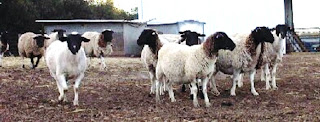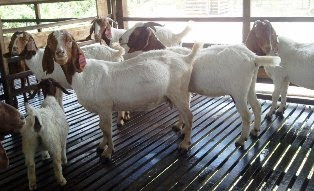 F1/F2
F1/F2
07 October 2010
05 October 2010
Dorper Guide cross bred percentages
F1 = ½ or 50%
F2 = ¾ or 75%
F3 = 7/8 or 87.5%
F4 = 15/16 or 93.75%
F5 = 31/32 or 96.88%
F6 = 63/64 or 98.84%
04 October 2010
Dorper Sheep News
Dorper Sheep Auction Exceeds Target
8/8/2010 -- BERNAMA
The country's first public auction for Dorper sheep at the Agropolitan Pekan project site in Runchang here today received an overwhelming response from bidders from all over country.
Fifty bidders took part in the auction, far exceeded its target of 20 bidders, said East Coast Economic Region Development Council (ECERDC) chief executive officer Datuk Jebasingham Issace John.
He said about 500 sheep classified into six categories were offered to the public, farmers and breeders at the auction which started at 11am.
The categories were male lambs for slaughter, male lambs for breeding, female lambs for slaughter, female lambs for breeding, culled ewes for slaughter and culled rams for slaughter.
"The bidders were willing to bid tens of thousands of ringgit for 10 sheep and this was beyond our own expectation," he said after the auction organised by the ECERDC in collaboration with the Federal Land Development Authority (Felda) here Sunday.
The Dorper sheep is a South African breed of domestic sheep developed by crossing Dorset Horn and the Blackhead Persian breeds raised under the East Coast Economic Region (ECER) Agropolitan Pekan project.
Touted as one of the most fertile of the sheep breeds with potential lambing intervals of only eight months, the Dorper sheep are well-adapted to various climates and conditions.
Jebasingham said the first bidding for 10 male lambs for breeding alone received bidding up to RM14,500 as the opening price was RM4,500.
He said the ECERDC expected to collect nearly RM300,000 in revenue from the auction, way above its target of RM120,000.
He said the auction would be an annual affair at Agropolitan Pekan which was set to become the biggest Dorper sheep producer in Asia with the production of 25,000 sheep in five years.
Copyright 2010 Bernama
30 September 2010
Slaughter Goats And Breeding Goats
For Oct / Nov 2010 shipment -
Average Shipment for Feral 35kg-40kg -
who are interested can make reservations now…..call for the best price
Price For Feral 35-40kg RM 450 minimum 10 heads - RM 440 minimum 30 heads, more than 50 heads may be negotiable with your take on the MAS Kargo - God willing.
For those interested in goat breeds like Boer / Saanen / Toggenburg / Anglo Nubian and Dorper and White Dorper sheep can also make reservations now for Shipment Oct / Nov. so don't wise you time call us at +6016-7406141/+6145151448 or email at pbramunia8@gmail.com
Boer Goats For Sale

Ready Stock Boer for clearance 30 head Boer does + 20 Boer kids =51 heads
- FB Does 7-10 average weight 35-45kg
- F5/F6 Purebreed 8-10 heads weight 35-45kg
- Does Kalahari Unregistered 3 heads weight 35-45kg
- Other Boer does brown head F3/F4
Total : RM 29,000 net/51 heads–just about RM 568.00 per head
Location at Pagoh Farm.
20 April 2010
Feral Buck For Slaughter
10 April 2010
Dorper Brief History
 White Dorper Stud Ewe
White Dorper Stud Ewe White Dorper Stud Ram
White Dorper Stud Ram
Black Dorper Stud Ewe

Black Dorper Stud Ram
Brief History
The breed was developed in
The Breeding program resulted in the development of the black headed and white headed Dorper. Successive Dorper breeding has shown it to be a fixed breed type, giving a reliable reproduction of features and characteristics. It is now numerically the second to largest sheep breed in
The breed was introduced into
Conformation
The animal is characteristically barrel shaped with short, dullish black or white hair on the head. A short, loose light covering of hair and wool (wool predominating on the forequarter) with a natural clean kemp underline, is a typical breed standard.
An even distribution of a thin layer of fat compliments the breed.
The Dorper sheds its fleece avoiding the need for mustering for shearing, crutching and fly control.
There is little difference between blackheaded and whiteheaded Dorpers - the choice is a matter of target market preference.
Characteristics
Economical
The Dorper are an economical breed because of their excellent feed utilization and conversion, they don't need shearing, crutching and mulesing, and they are disease resistant
Meat production:
Purebred Dorper rams reach a liveweight of 90-120 kg and ewes 50-80kg. The Dorper carcass has a good conformation and fat distribution.
Trials and producer experience in
Adaptable:
The Dorper is now well adapted in
Hardy
The Dorpers have the ability to thrive in harsh conditions. They were developed to be turned off quickly from arid, extensive grazing conditions in
Fertile
The Dorper is one of the most fertile of the sheep breeds, with potential lambing intervals of only 8 months. Lambing percentages in excess of 150% (2.25 lambs per annum) are possible and 100% is feasible for most areas.
Short lambing intervals have various advantages, of which greater selection possibilities and the sale of larger numbers of lambs are the most important.
Good mothering qualities
The Dorper ewe is a very good mother and protective of her young. Multiple births are common, with some instances of triplets recorded. Lambs are extremely mobile at birth and survival rates are high.
The Dorper ewe produces a large quantity of milk, aiding lamb survival and early growth.
Good grazing habits
They are non-selective grazers. Experience so far suggests that Dorpers can adapt to most grazing conditions. There is evidence that they prefer fibre to grains and they respond well to good quality hay.
Purebred lambs will start to graze in the first few days after birth. F1 lambs after about two weeks.
The Dorper can be advantageously incorporated into under-utilized pastures of lesser quality, thus converting a poor asset into profit.
Continuous breeding season
The Dorper is polyoestrus (can breed continually, with no defined season). Their breeding intervals can be as short as 8 months or 3 times in 2 years. Running rams with ewes continuously is one option that may stimulate reproduction, however it is also likely that ewes will adjust their fertility according to conditions.
Fast growing
Dorper lambs have an inherent growth potential (ability to graze at an early age) They grow rapidly and can attain a high weaning weight.
Dorpers respond well to increased planes of nutrition, giving growers the potential to increase weights rapidly in response to market demands.
So... some reasons to breed Dorpers:
- No shearing required
- Resistance to fly strike
- No mulesing
- No crutching
- Less chemicals
- Non selective grazers
- Continuous breeding season
- High reproduction rate
- Rapid weight gain
- Excellent carcase conformation and fat distribution
- Quiet temperament
- Highly adaptable - thrive in arid, semi-tropical to cool temperate areas
- Hardy and disease resistant
- Early sexual maturity
- Excellent mothers, easy lambers
28 March 2010
Feral Bucks & Boer x wethers
Beside as a Boer breeder and handle enquires for importer we also handling and supplying slaughtering Feral bucks and Boer x wethers.
Please use the chart below as a guide to pricing for Feral -v- wethers
Type | Weight | Ex KLIA Cost | Ex Farm Cost |
Feral | Ave 35kg per head RM 520 | RM 460 min.10 head | RM 480 min 5 head |
Feral | Ave 40kg per head RM 600 | RM 490 min. 10 head | RM 510 min 5 head |
Boer x wethers | Avg 35kg per head 550 | RM 470 min 10 head | RM 530 Min. 5 head |
Boer x wethers | Avg 40 kg Per head 590 | RM 500 Min 10 head | RM 520 Min 5 head |
29 January 2010
Takes to start a goat farm
Learn about goats
Study and know everything there is to know about goats. Learn their mating patterns. Learn how many kids a goat mom can produce. Learn the best food for goats and their eating habits. What’s the life span of a goat? Learn how to care for goats and learn its basic needs.
Decide what type of goat business you want to do
Goat farming is a diversified business. Goats produce diary and they also make great meat. Goats can also be breed to sell. As a business owner explore these avenues where in you can make money. Decide on which areas you want to focus your attention on. Identify the purpose of your goat farming business.
Determine on how big you want your business to start
Study your business plan and business moves carefully. Determine the number of goats you want to begin with. Pick a number that would be substantially enough to get things moving depending on the purpose of your goat farming business. Is it 10 or 20? Then determine also a supplier who can supply good quality stock of goats.
Purchase land you can develop into a farm
When finding the right place to develop your farm, it is important you make a list of what you want to find first. If you make a list of what you need in a land, it will be easier for you to recognize if a certain place is the right one for your business. Find a location with good terrain for goats, ample grasslands and a good water supply. The area should not be too hot nor is it too good to have it open for predators. Consider talking to a real estate agent about your land needs. Survey the web too for possible lands that could easily be converted into a goat farm.
Invest farming equipment
Purchase farming tools for your business. Begin with fortifying your land perimeter. Install fencing around your area to keep predators and other unwanted elements away from your goats. Purchase grooming tools for your goats as well as hire a vet who can do regular check ups on them.
Advertise
Get the news out that you opened a business. Use your circles of influence and promote your goat farm. Place signage along the road to advertise your business. Develop a website where people can check your farm virtually.
20 January 2010
Breeding Goat Quotation
Greeting ......
For the next shipment on Febuary 2010 as we started collecting order.
For BULK ORDER
PLEASE CALL 016 7406141
EMAIL :pbramunia8@gmail.com
Our quote pirice for Feb. are as follow ;-
EX-PRICE
1 | BOER FB BUCK REGISTERTED 18 BULAN 55KG . | RM 2,400 |
2 | BOER FB BUCK UNREGISTERDED 18 BULAN 50KG | RM 1,700 |
3 | BOER FB DOES REGISTERED 12 BULAN 35KG | RM 2,000 |
4 | BOER FB DOES UNREGISTERED 35KG | RM 1,600 |
5 | BOER DOES F1/F2 WHITE HEAD WHITE BODY AVG 25KG | RM 700 |
6 | BOER DOES F3/F4 RED HEAD WHITE BODY AVG 30KG | RM 1,050 |
7 | BOER DOES F5/F6 RED HEAD WHITE BODY AVG 35KG | RM 1,200 |
8 | KALAHARI FB BUCK REG 55KG | RM 2,500 |
9 | KALAHARI FB DOES REG AVG 30KG | RM 2,100 |
10 | KALAHARI FB DOES UNREG | RM 1,500 |
11 | SAANEN FB BUCK REG 18 BULAN | RM 2,600 |
12 | SAANEN FB DOES REG 16 BULAN | RM 2,500 |
13 | SAANEN CROSS 16 MONTH | RM 1,500 |
14 | Dorper F3/F4 35kg | RM 1.350 |
15 | Dorper RAM Purebreed | RM 2,500 |

